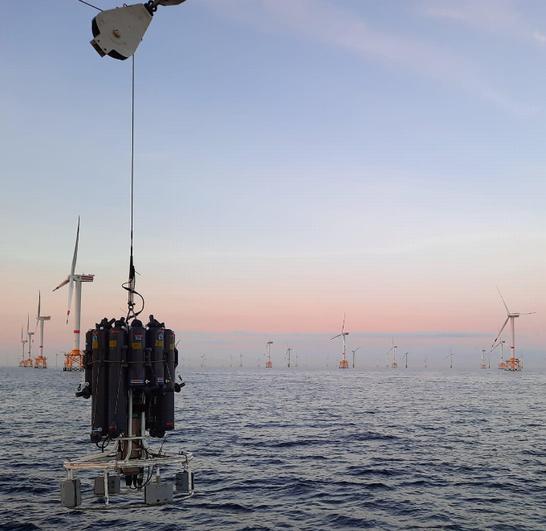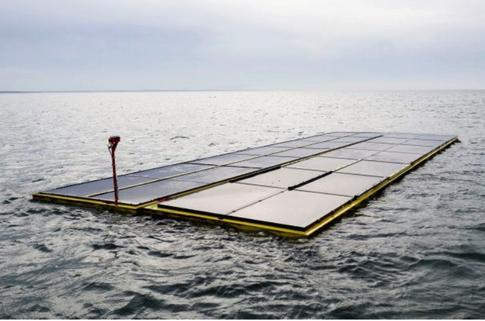Science Joins Industry to Float Solar at Sea
By Sunny Lewis for MaxImpact

GHENT, Belgium, July 9, 2023 (Maximpact.com Sustainability News) – To meet society’s growing need for renewable energy, scientists and engineers are exploring the potential of adding offshore solar power generation to existing offshore wind farms.
As suitable land for siting extensive solar arrays grows more difficult to find, authorities are increasingly looking at multi-use of marine space. Since the offshore grid infrastructure shows good potential for combined use, the integration of offshore floating solar installations with current and future offshore wind sites presents an opportunity to produce large volumes of additional renewable energy.
To date, it is wind farms that produce most renewable energy production at sea. Belgium has developed into one of the international frontrunner countries in this field, and more attention is being paid to emerging opportunities to generate solar power at sea. The complementary nature of wind and solar technology has been confirmed all over the world.
“Floating solar panels at sea are part of the solution to make our North Sea the largest green power plant in Europe,” Belgium’s Minister for Energy Tinne Van der Straeten said.
Yet, both the technology and the understanding of the environmental impacts of floating solar panels are still in their infancy. The technology must be further developed, and we must ensure that this is done with respect for the marine environment.
In a new pilot project known as Eco-designing Marine Photovoltaic Installations, or EcoMPV, scientists and industrial partners are working together to deepen their knowledge about environmental challenges related to offshore floating photovoltaic installations, aiming at technical solutions to mitigate undesired consequences and maximise beneficial impacts.
In the EcoMPV project, technological developments and environmental research go hand in hand.
By working together in this pilot project, science and industry are learning to comprehend the impact of floating solar panels on the offshore environment. Their goal is to be able to avoid or mitigate the negative environmental effects as much as possible from the start of commercial initiatives.
Vincent Van Quickenborne is a member of the conservative-liberal party Open Flemish Liberals and Democrats who serves as Belgium’s minister in charge of the North Sea as well as deputy prime minister and minister of justice. “With EcoMPV, important steps are being taken to also correctly assess the environmental impact of floating solar panels. This is important. The potential of floating solar panels is estimated to be high. If we want to use them later on a commercial scale, it is necessary to also take into account their effects on the marine environment in order to avoid or mitigate them as much as possible,” he said.
“With this, Belgium once again shows that economy and ecology go hand in hand,” Van Quickenborne said.
In May and June, scientists from the Royal Belgian Institute of Natural Sciences (RBINS) installed three experimental littoral modules at the edge of the Mermaid offshore wind farm in the operational Belgian offshore energy zone.
The installation of the three experimental modules at sea was completed on June 28. These floating modules are equipped with settlement plates in various materials, to study the colonisation potential for marine animals and the habitat provisioning of artificial floating structures, including offshore floating photovoltaic, PV, systems.
This early study will attempt to fill in knowledge gaps about:
- altered underwater light field, hydrodynamics, pelagic biogeochemistry and primary production,
- the artificial habitat provision for colonising animals and fish, and
- effects on carbon fluxes and sequestration

The modules were designed and developed by Jan De Nul Group in collaboration with RBINS, with support of the European Marine Biological Resource Centre. The installation was carried out on board the RV Belgica and the Zeetijger, and the modules will remain in the water for around 18 months. They will be monitored at regular intervals to track the colonization process.
Advice for eco-designing offshore PV installations, paving the way to environmental licensing of the technology, will be formulated.
The location for the experimental tests has been chosen to be as similar as possible to the Princess Elisabeth Zone (PEZ), which is designated as a new zone for offshore renewable energy production in the Belgian Marine Spatial Plan 2020-2026. Although the focus of the PEZ remains mainly on offshore wind, seeking to combine wind turbines with floating solar panels seems promising.
Energy Minister Van der Straeten, a member of the Groen Party, said, “In our country, we have the brainpower and the will to work out solutions to the challenges of the future. With the Energy Transition Fund, we want to kick start those solutions. The federal government is supporting 21 top projects including EcoMPV.”
“EcoMPV shows once again that we can count on Belgian know-how and expertise for those solutions,” asserted Van der Straeten, who while serving in the Belgian Parliament In 2010 co-founded Brussels-based law firm Blixt specializing in energy law.
EcoMPV is financed by the Energy Transition Fund of the FPS Economy, AD Energy, started in November 2022 and will run for three years.
The Energy Transition Fund budget for 2023 is €25 million, which can be awarded as a grant to projects that relate to research and development, investment in research infrastructure, or innovation by small and medium-sized enterprises.
The project is coordinated by the Marine Ecology and Management research team of the Royal Belgian Institute of Natural Sciences, with Ghent University as a scientific partner and Tractebel, Jan De Nul Group and DEME Group as industrial partners.
The EcoMPV aims to:
- Increase the knowledge on the effects of floating photovoltaic structures on hydrodynamics and phytoplankton productivity;
- Investigate the habitat provision by floating structures to marine life, including colonising fauna and attraction by fish;
- Describe effects of colonising fauna that can foul floating structures on the surrounding sediments, including the burial and sequestration of carbon in sediments;
- Provide input on the nature-inclusive design of floating photovoltaic systems, based on the results of the previous objectives, as to ensure the environmental sustainability of these systems.
The Energy Transition Fund first saw the light of day in 2017, aiming to support energy transition research, development and innovation. A total of 51 proposals were received following the November 2022 project call. Of these, 21 were selected to be considered for grants.
Through the fund, the expertise of companies and start-ups will be tapped to accelerate the energy transition.
First ‘High Wave’ Solar Farm Contract Awarded
On April 24, the Dutch company Oceans of Energy won the contract for installing and operating offshore solar inside the Hollandse Kust Noord offshore wind park by CrossWind, a joint-venture between Shell and Eneco.
This is the first offshore solar farm in the world to be connected, installed and operated within a wind farm in high wave conditions. Oceans of Energy said in a statement that the offshore solar farm will be realized in 2025, and the 69 turbine wind power development located 18.5 km off the coast of the Netherlands near the village of Egmond aan Zee will be operational by the end of this year.
The solar floating array, expected to be operating by 2025, marks a key stride forward for the technology, which has now moved from installations on water reservoirs and inland lakes to high-wave environment offshore sites.

“With offshore solar added to offshore wind it is possible to also produce energy on sunny but less windy days and hence increase the utilization of the offshore power grid infrastructure,” Oceans of Energy CEO Allard van Hoeken said.
“The solar panels will be situated in-between the offshore wind turbines, an efficient way of sharing the sea space,” van Hoeken explained. “CrossWind’s Hollandse Kust Noord project is an innovative offshore wind park that will use cutting-edge technologies and engineering solutions to improve the flexibility of offshore wind farms.”
“We will add offshore solar to offshore wind. Our performance and our system will be key for the success of the innovational part of the offshore wind farm,” van Hoeken said. “This is a large responsibility as Hollandse Kust Noord will function as an example for combined offshore wind and solar parks in the future.”